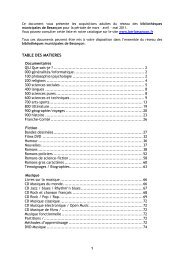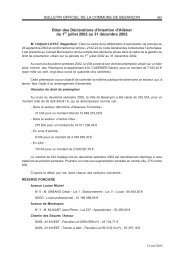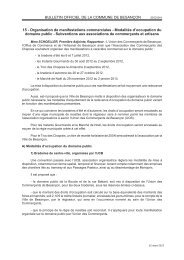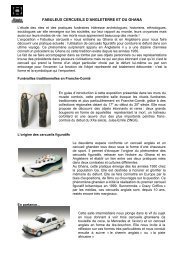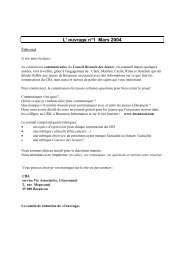An inventory of works within the city walls - Besançon
An inventory of works within the city walls - Besançon
An inventory of works within the city walls - Besançon
Create successful ePaper yourself
Turn your PDF publications into a flip-book with our unique Google optimized e-Paper software.
The loop defences<br />
Built on <strong>the</strong> left bank <strong>of</strong> <strong>the</strong> Doubs,<br />
<strong>the</strong>se defence <strong>works</strong> sealed <strong>of</strong>f <strong>the</strong><br />
Doubs from <strong>the</strong> Porte de Malpas<br />
gate to <strong>the</strong> Porte Taillée gate. From<br />
<strong>the</strong> Porte de Malpas gate which<br />
today no longer exists, to <strong>the</strong> Porte<br />
Notre-Dame gate stretches <strong>the</strong><br />
Tarragnoz district. From <strong>the</strong> Porte<br />
Notre-Dame gate, <strong>the</strong> starting point <strong>of</strong><br />
<strong>the</strong> ring <strong>of</strong> defences around <strong>the</strong> town,<br />
on <strong>the</strong> Cordeliers flank, 1,500 metres <strong>of</strong><br />
ramparts dotted with bastioned towers<br />
and bastions protected <strong>the</strong> town. From<br />
<strong>the</strong> Cordeliers flank to <strong>the</strong> Saint-Esprit<br />
bastion, 500 metres <strong>of</strong> quays with<br />
casemates protected <strong>the</strong> bank <strong>of</strong> <strong>the</strong><br />
Doubs. This was a double defence work<br />
at Chamars, protecting an arm <strong>of</strong> <strong>the</strong><br />
Doubs which has now disappeared.<br />
From <strong>the</strong> Saint-Esprit bastion to <strong>the</strong><br />
Porte Rivotte gate, ano<strong>the</strong>r entrance<br />
to <strong>the</strong> town where <strong>the</strong> ring <strong>of</strong> defences<br />
around <strong>the</strong> town is completed with<br />
ano<strong>the</strong>r 1,500 metres <strong>of</strong> ramparts<br />
reinforced by bastions or towers border<br />
on <strong>the</strong> river. The Rivotte district<br />
stretches from <strong>the</strong> Porte Rivotte gate,<br />
<strong>the</strong> town’s real entrance, to <strong>the</strong> Porte<br />
Taillée gate. Porte Notre-Dame and<br />
Porte Rivotte gates are linked to <strong>the</strong><br />
citadel by a fortified circular walkway.<br />
From <strong>the</strong> seventeenth to <strong>the</strong> nineteenth<br />
century, <strong>the</strong> fortifications had <strong>the</strong>ir<br />
« feet in <strong>the</strong> water ». It was <strong>the</strong> building<br />
<strong>of</strong> <strong>the</strong> Canal Monsieur (which would<br />
become <strong>the</strong> Rhone - Rhine Canal) that<br />
modified <strong>the</strong>ir aspect, with <strong>the</strong> creation<br />
<strong>of</strong> <strong>the</strong> towpath at <strong>the</strong> foot <strong>of</strong> <strong>the</strong><br />
ramparts or accessed along <strong>the</strong> Doubs.<br />
Created by Vauban from 1680<br />
onwards, <strong>the</strong>se defences succeeded <strong>the</strong><br />
medieval fortifications restored and<br />
added to by Charles V in <strong>the</strong> sixteenth<br />
century, reusing <strong>the</strong> ancient fortifications<br />
wherever possible. Because he had<br />
led <strong>the</strong> 1674 siege against <strong>the</strong> town,<br />
Vauban knew all its weak points and<br />
was <strong>the</strong>refore in a position to design <strong>the</strong><br />
best possible defence system.<br />
In 1687 he invented <strong>the</strong> bastioned<br />
towers with thick <strong>walls</strong> and two firing<br />
levels. These towers solved <strong>the</strong> problem<br />
<strong>of</strong> domination by <strong>the</strong> neighbouring<br />
heights <strong>of</strong> Bregille and Chaudanne<br />
over <strong>the</strong> town (it was at Bregille and in<br />
particular at Chaudanne that Vauban<br />
had installed his batteries in 1674<br />
to take <strong>the</strong> town and <strong>the</strong> citadel).<br />
Many engineers would work under<br />
Vauban’s command at <strong>Besançon</strong> and<br />
he himself came about twenty times to<br />
supervise <strong>the</strong> town’s fortification <strong>works</strong>.<br />
The building <strong>of</strong> <strong>the</strong> ramparts began<br />
at <strong>the</strong> same time as <strong>the</strong> citadel, and,<br />
scarcely had <strong>the</strong>y been finished<br />
than, <strong>the</strong> town’s ring <strong>of</strong> defences<br />
was being constantly repaired,<br />
improved and modified.



